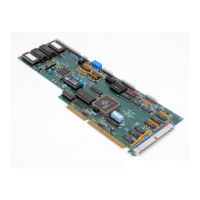138 • Chapter 10 Theory of Operation DMC-1000
DAC
The DAC or D-to-A converter converts a 16-bit number to an analog voltage. The input range of the
numbers is 65536 and the output voltage range is +/-10V or 20V. Therefore, the effective gain of the
DAC is
K= 20/65536 = 0.0003 [V/count]
Digital Filter
The digital filter has a transfer function of D(z) = K(z-A)/z + Cz/z-1 and a sampling time of T.
The filter parameters, K, A and C are selected by the instructions KP, KD, KI or by GN, ZR and KI,
respectively. The relationship between the filter coefficients and the instructions are:
K = (KP + KD) ⋅ 4 or K = GN
4
A = KD/(KP + KD) or A = ZR
C = KI/2
This filter includes a lead compensation and an integrator. It is equivalent to a continuous PID filter
with a transfer function G(s).
G(s) = P + sD + I/s
P = K(1-A) = 4
⋅
KP
D = T
⋅ K⋅ A = 4 ⋅ T
KD
I = C/T = KI/2T
For example, if the filter parameters of the DMC-1000 are
KP = 4
KD = 36
KI = 2
T = 0.001 s
the digital filter coefficients are
K = 160
A = 0.9
C = 1
and the equivalent continuous filter, G(s), is
G(s) = 16 + 0.144s + 1000/s
ZOH
The ZOH, or zero-order-hold, represents the effect of the sampling process, where the motor command
is updated once per sampling period. The effect of the ZOH can be modeled by the transfer function
H(s) = 1/(1+sT/2)
If the sampling period is T = 0.001, for example, H(s) becomes:
H(s) = 2000/(s+2000)
However, in most applications, H(s) may be approximated as one.
This completes the modeling of the system elements. Next, we discuss the system analysis.
Artisan Technology Group - Quality Instrumentation ... Guaranteed | (888) 88-SOURCE | www.artisantg.com

